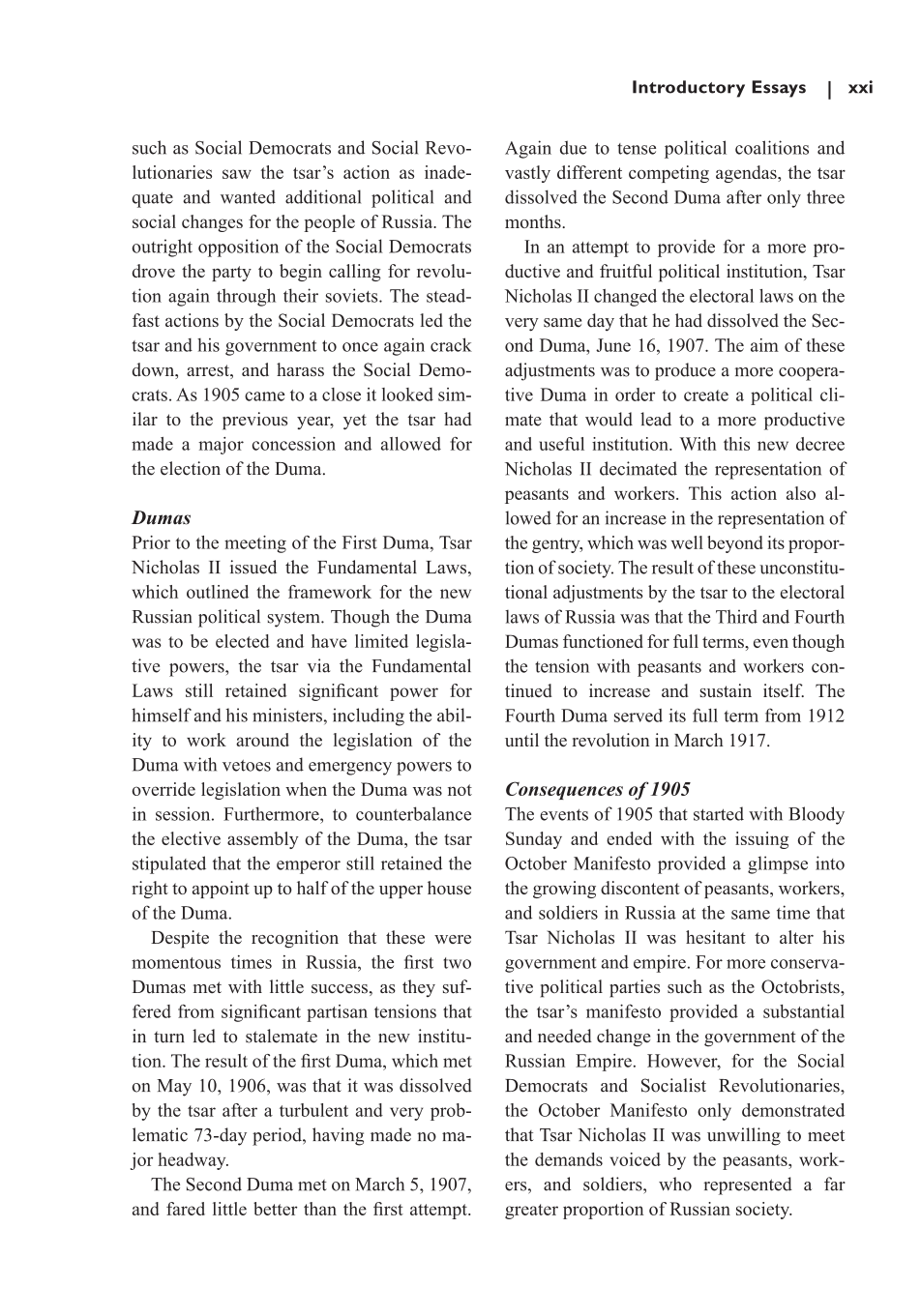Introductory Essays | xxi
such as Social Democrats and Social Revo-
lutionaries saw the tsar’s action as inade-
quate and wanted additional political and
social changes for the people of Russia. The
outright opposition of the Social Democrats
drove the party to begin calling for revolu-
tion again through their soviets. The stead-
fast actions by the Social Democrats led the
tsar and his government to once again crack
down, arrest, and harass the Social Demo-
crats. As 1905 came to a close it looked sim-
ilar to the previous year, yet the tsar had
made a major concession and allowed for
the election of the Duma.
Dumas
Prior to the meeting of the First Duma, Tsar
Nicholas II issued the Fundamental Laws,
which outlined the framework for the new
Russian political system. Though the Duma
was to be elected and have limited legisla-
tive powers, the tsar via the Fundamental
Laws still retained significant power for
himself and his ministers, including the abil-
ity to work around the legislation of the
Duma with vetoes and emergency powers to
override legislation when the Duma was not
in session. Furthermore, to counterbalance
the elective assembly of the Duma, the tsar
stipulated that the emperor still retained the
right to appoint up to half of the upper house
of the Duma.
Despite the recognition that these were
momentous times in Russia, the first two
Dumas met with little success, as they suf-
fered from significant partisan tensions that
in turn led to stalemate in the new institu-
tion. The result of the first Duma, which met
on May 10, 1906, was that it was dissolved
by the tsar after a turbulent and very prob-
lematic 73-day period, having made no ma-
jor headway.
The Second Duma met on March 5, 1907,
and fared little better than the first attempt.
Again due to tense political coalitions and
vastly different competing agendas, the tsar
dissolved the Second Duma after only three
months.
In an attempt to provide for a more pro-
ductive and fruitful political institution, Tsar
Nicholas II changed the electoral laws on the
very same day that he had dissolved the Sec-
ond Duma, June 16, 1907. The aim of these
adjustments was to produce a more coopera-
tive Duma in order to create a political cli-
mate that would lead to a more productive
and useful institution. With this new decree
Nicholas II decimated the representation of
peasants and workers. This action also al-
lowed for an increase in the representation of
the gentry, which was well beyond its propor-
tion of society. The result of these unconstitu-
tional adjustments by the tsar to the electoral
laws of Russia was that the Third and Fourth
Dumas functioned for full terms, even though
the tension with peasants and workers con-
tinued to increase and sustain itself. The
Fourth Duma served its full term from 1912
until the revolution in March 1917.
Consequences of 1905
The events of 1905 that started with Bloody
Sunday and ended with the issuing of the
October Manifesto provided a glimpse into
the growing discontent of peasants, workers,
and soldiers in Russia at the same time that
Tsar Nicholas II was hesitant to alter his
government and empire. For more conserva-
tive political parties such as the Octobrists,
the tsar’s manifesto provided a substantial
and needed change in the government of the
Russian Empire. However, for the Social
Democrats and Socialist Revolutionaries,
the October Manifesto only demonstrated
that Tsar Nicholas II was unwilling to meet
the demands voiced by the peasants, work-
ers, and soldiers, who represented a far
greater proportion of Russian society.










































































































































































































































































































